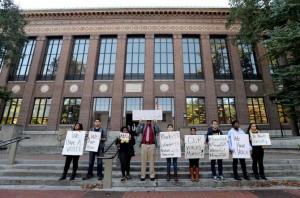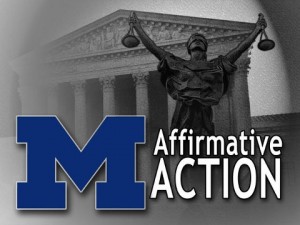Anti-Affirmative Action Ruling Causes Grave Concern

Anti-Affirmative Action Ruling Causes Grave Concern
By Ed White
The anti-affirmative action ruling causes grave concern among those who are directly and negatively affected, particularly black students, and the reaction to the Supreme Court’s ruling has been swift .
The U.S. Supreme Court decision Tuesday upholding the Michigan’s ban on using race as a factor in college admissions comes as the University of Michigan has been taking steps to reach out to minorities and make them feel welcome on campus.
Blacks made up just 4.6 percent of undergraduate students last fall, a figure that has dropped since voters in 2006 said race couldn’t be used as a factor in the selection process. Nearly eight years later, the Supreme Court said the Michigan constitutional amendment will stand.
“To take away the rights of minorities is a shocking decision,” said George Washington, a Detroit lawyer who challenged the law. “With this, and the voting rights decision last year, it’s clear the Supreme Court is undoing the rights gained by blacks and Latino people in the 1960s and 1970s.”
The university declined to make officials available for an interview. It released a statement from President Mary Sue Coleman, who said the school would use “every legal tool at our disposal to bring together a diverse student body.”
Asians make up 13 percent of undergraduates, well above the state’s Asian population, and Hispanics represent 4.4 percent.
Leaders of the Black Student Union have proposed ways to increase black enrollment and enhance the campus for minorities. They include lower housing costs for low-income students, better promotion of emergency financial assistance and improvements at a multicultural center.
The group wants black enrollment to be 10 percent, which is closer to the state’s 14 percent black population. The university last week said it’s had good conversations with the group and is upgrading the multicultural center while a site for an additional center is being explored.
The university also is making money available for transportation between the campus and surrounding communities when buses aren’t available.
Jennifer Gratz of Fort Myers, Fla., was involved in the campaign for the constitutional amendment and said the Supreme Court decision is a “great victory” for Michigan voters. She sued over the university’s racial preferences in 1997 after being rejected for admission.
Gratz, who is white, recently challenged a black Detroit high school senior to a debate about affirmative action after Brooke Kimbrough appeared at a rally to complain about not getting accepted to the University of Michigan with a 3.6 grade-point average and a 23 on the ACT.
Attorney General Bill Schuette, who defended the amendment at the nation’s top court, praised the 6-2 decision.
“We need to have diversity in our campuses … across the state of Michigan and across America,” he said. “And we need to achieve this diverse student population by constitutional means. That’s the message of this opinion.”While the focus has been on the University of Michigan, the ban on affirmative action in college admissions applies to all public schools. Michigan State University, the largest school in the state, said blacks were 6 percent of undergraduates last fall.
Washington said the University of Michigan could boost minority enrollment by dropping ACT and SAT scores from the admissions process. He said blacks and Hispanics historically post lower scores than white students and are rejected.
Washington also called for sit-ins. “The Supreme Court has taken the gloves off, so we’ll be taking the gloves off,” he said.
Coleman has publicly acknowledged that minority students have concerns. “We hear loud and clear that students of color feel isolated and marginalized, and that our frequently declared commitment to diversity is perceived as disingenuous,” she said in February. “Students here and elsewhere are raising real – and painful – concerns about campus climate and the diminishing number of students of color in classrooms.”
Decision: http://on.freep.com/PrisQr
Copyright The Associated Press
AP reporters David Eggert and Emma Fidel in Lansing, Mich., contributed to this report.
Feature Photo Credit:

